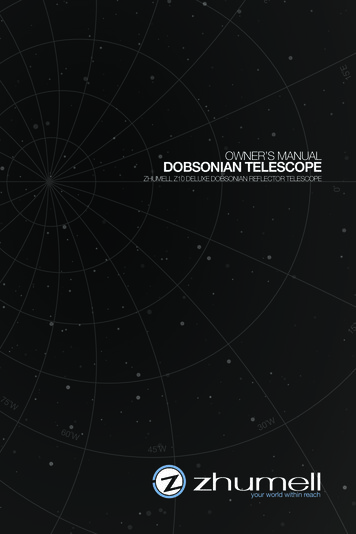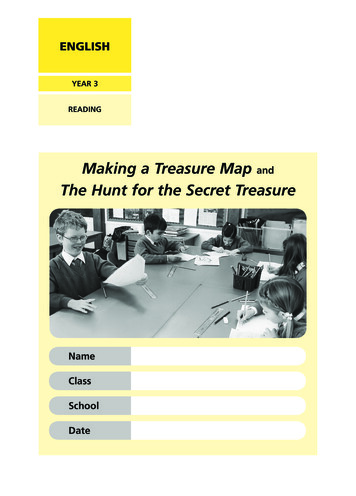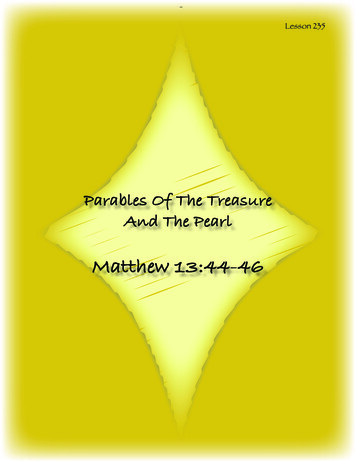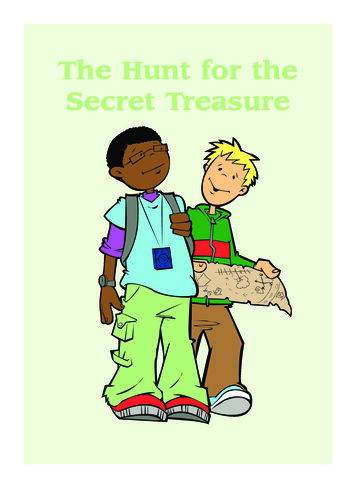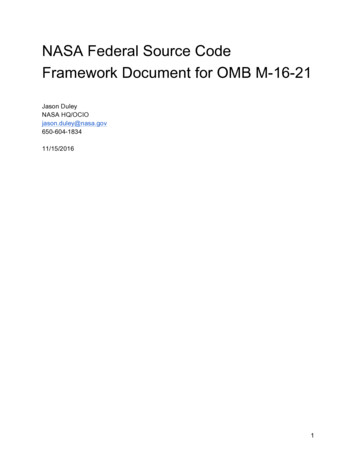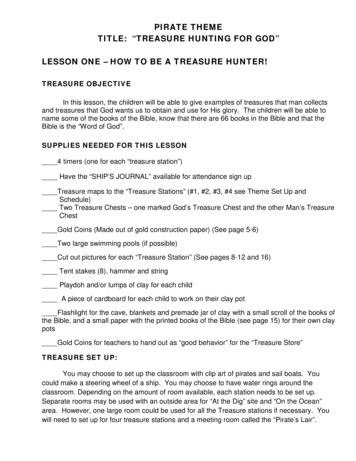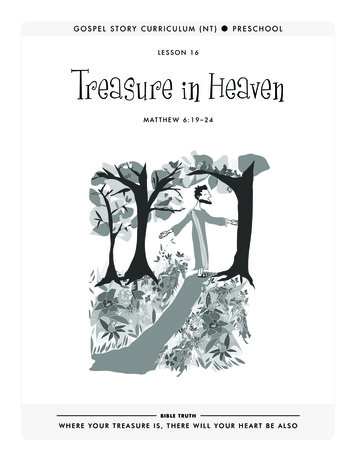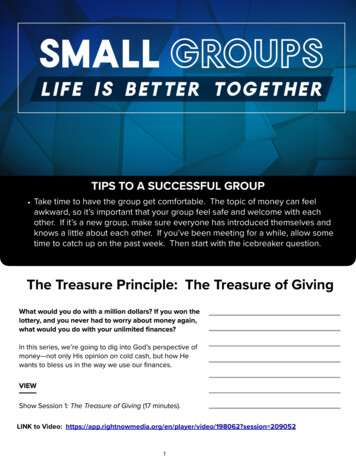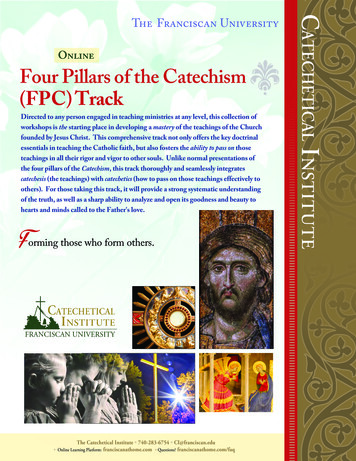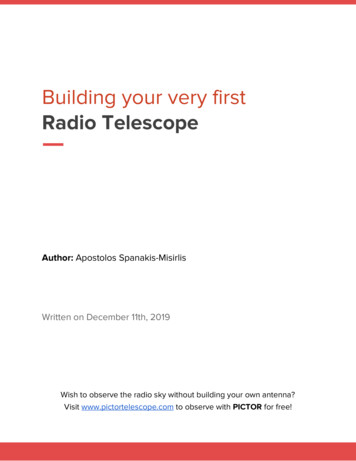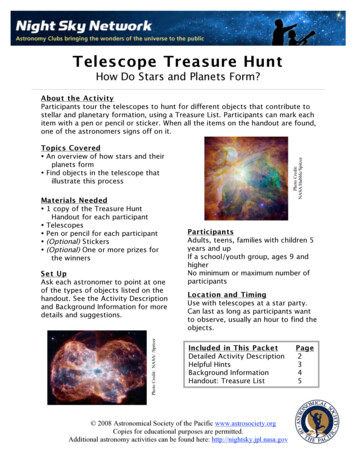
Transcription
Telescope Treasure HuntHow Do Stars and Planets Form?About the Ac tivityParticipants tour the telescopes to hunt for different objects that contribute tostellar and planetary formation, using a Treasure List. Participants can mark eachitem with a pen or pencil or sticker. When all the items on the handout are found,one of the astronomers signs off on it.Materials Needed 1 copy of the Treasure HuntHandout for each participant Telescopes Pen or pencil for each participant (Optional) Stickers (Optional) One or more prizes forthe winnersPhoto Credit: NASA/ /SpitzerSe t UpAsk each astronomer to point at oneof the types of objects listed on thehandout. See the Activity Descriptionand Background Information for moredetails and suggestions.Photo Credit:NASA/Hubble/SpitzerTopics Covered An overview of how stars and theirplanets form Find objects in the telescope thatillustrate this processParticipantsAdults, teens, families with children 5years and upIf a school/youth group, ages 9 andhigherNo minimum or maximum number ofparticipantsLocation and TimingUse with telescopes at a star party.Can last as long as participants wantto observe, usually an hour to find theobjects.Included in This PacketDetailed Activity DescriptionHelpful HintsBackground InformationHandout: Treasure List 2008 Astronomical Society of the Pacific www.astrosociety.orgCopies for educational purposes are permitted.Additional astronomy activities can be found here: http://nightsky.jpl.nasa.govPage2345
Detailed Ac tivity DescriptionLeader’s RoleParticipants’Roles(Anticipated)Preparation Notes:To Do:1. Each participating amateur astronomer may pick anyobject(s) he or she wishes to show and that his or hertelescope is capable of viewing.2. Prepare the astronomers by giving each person a copy ofthe Treasure List. Explain that your visitors will havethese and be on a “treasure hunt” to look at these objects.The information on the back of the Treasure List may giveeach astronomer some talking points about their object.(Of course, there may be objects that some of theastronomers will be viewing that are not on the TreasureList – like the Moon, globular clusters, or another galaxy– you can refer to these as “bonus” or “surprise” items).Note:If examples of one or more of the objects on the Treasure List arenot accessible (sky too bright, out of range of the telescopes, noexamples far enough above the horizon) of the items on theTreasure List, you can have someone explaining about the object(e.g. supernova remnant Crab Nebula) and indicating its positionin the sky if it was dark enough to see it, or when you would beable to see it.Introduction:Introduce the activity and explain to the participants what toexpect. You can use the following script, if you wish:To Say:Tonight, you will be on a treasure hunt as you tour the telescopes.You can find many different and exotic objects found in ourGalaxy that contribute to the formation of stars and planets.Travel from telescope to telescope and hunt for these amazingobjects. You will receive a Treasure List and set of stickers. Foreach object on the Treasure List that you see through a telescope,place one of your stickers next to that object. (Hold up theTreasure List)2Participants tourfrom one telescopeto another to viewdifferent objects inthe night sky.At each telescope,participants canplace a sticker ontheir Treasure Listnext to the objectthey viewed.
To Say (continued):When you have found all the items on the Treasure List, take theList to any one of the astronomers and he or she will sign off onyour Treasure List.Look up at all the stars. Where do you think they come from?Have they always been there? How many of these do you thinkwe will find planets around – like the planet you are standing on?Discuss questionsTonight, you will see a star, other than our own Sun, that actuallyhas been found to have planets orbiting around it. You won’t beable to see the planets themselves, but as you gaze at the star,imagine the kinds of planets orbiting the star – does it have anyplanets like ours? Any with life?Over the next 25 years, NASA will be sponsoring a series ofmissions that will answer those questions.So enjoy your treasure hunt and discover the secrets of the sky!You may pick up your Treasure Lists and stickers indicatehow you are distributing the Treasure Lists and stickers .Or, even more simply:Did you know that the calcium in your bones and the oxygen youbreathe were formed inside of a star? Here’s a Treasure List totake on a treasure hunt through the telescopes to view objects inthe sky that make stars like our Sun and planets like the Earthwe’re standing on. Place one of these stickers next to each objectyou see.Helpful HintsTo simplify/shorten: Carry out Telescope Treasure Hunt activity withoutusing stickers. Participants mark items they find with pen or pencil. Kidsreally enjoy the stickers, though.3 2008 Astronomical Society of the Pacific www.astrosociety.orgCopies for educational purposes are permitted.Additional astronomy activities can be found here: http://nightsky.jpl.nasa.gov
Background InformationA description of how each type of object contributes to star and planetformation is on the Treasure List. For more e/origins.htmlPlease Note: Not all objects needed for the Treasure Hunt are visible inthe sky all year around (see NOTEs below).Examples of objects in eachcategory on the Treasure List:Supernova Remnant :M1: Crab NebulaNGC 6960 & NGC 6992: Veil NebulaNOTE: There are no “ Supernova Remnants” visible through amateurtelescopes from about mid-April to the end of June in the earlyevening (before 11 p.m.). The Crab Nebula is no longer visible after midApril and the Veil Nebula does not get high enough to be seen (and onlyunder very dark skies) until the beginning of July.Planetary Nebula:M57: Ring NebulaM27: Dumbbell NebulaNGC 2392: Eskimo or Clown NebulaClouds of Gas and Dust (star forming regions) :M8: Lagoon NebulaM20: Trifid NebulaNGC 7000: North American NebulaM42: Orion NebulaNOTE: There are no “Clouds of Gas and Dust” visible throughamateur telescopes from May to the end of June in the early evening(before 11 p.m.). The Orion Nebula is no longer visible after the end ofApril and the Lagoon (M8), the Trifid (M20), and the North AmericanNebula (NGC 7000) all start coming into view toward the end of June.Open S tar Clusters:M11: Wild DuckM45: PleiadesNGC 869 and 884: Perseus Double ClusterA S tar with Planets:See the star maps in the Activity: “Where are the Distant Worlds?”A Planet Orbiting our Sun :Check your favorite astronomy reference or magazine for star maps thatshow planets visible at the time you are observing4 2008 Astronomical Society of the Pacific www.astrosociety.orgCopies for educational purposes are permitted.Additional astronomy activities can be found here: http://nightsky.jpl.nasa.gov
Treasure ListHow do stars and planets form?For over 400 years astronomers have been asking this question and we still only havesome of the answers.Visit the telescopes to hunt for these objects that contribute to building planets like theEarth you are standing on. Place a sticker next to each type of object you see.12Type: Supernova Remnant –The remains of an exploded starType: Planetary Nebula – a Dying Star3Type: Cloud of Gas and Dust – Star Nursery4Type: Open Star Cluster – Young Stars56VenusMarsJupiterSaturnA Planet Orbiting our SunA StarwithPlanetsFind a star where planets formedTreasure Hunt Completed! Date 2004 Astronomical Society of the Pacific. Copies for non-profit educational purposes are permitted.Images courtesy of Starry Night Pro SPACE.com www.starrynight.com . Extrasolar planet image by Lynette Cook.
1. Supernova RemnantA massive star ends its life in a spectacular supernova explosion with the brilliance of 100 millionSuns. A rapidly expanding, glowing shell of material called a supernova remnant contains silicon, iron,and carbon formed inside the star during its life, as well as heavier elements like copper and lead forgedin the explosion.Space is enriched with the ingredients to make new stars and planets. And life. The iron in your bloodoriginated inside of a star.2. Planetary Nebula – A Dying StarAfter living for billions of years, a star like our Sun dies, slowly ejecting its outer layers and enrichingspace with a variety of elements essential for life as we know it.One of these elements, oxygen, can combine with the hydrogen gas in space to make water for futureplanetary systems and the life that might evolve on them.3. Clouds of Gas and DustHuge clouds of gas and dust hundreds of light years across reside between the stars. Denser areas ofthe cloud collapse under the force of gravity to form new stars, recycling the material ejected fromsupernovae and dying stars.4. Open Star ClusterBorn together from the same cloud of gas and dust, open clusters of stars eventually overcome theirmutual gravitational attraction and drift apart. Many remain linked as double or triple star systems.Others live alone, like our Sun. There may be planets around some of these stars!5. A Planet Orbiting our SunOur Sun is a star that has planets. From a few light years away, our Sun would look like any other star.Do you suppose a civilization living on a planet around another star can see one of the Sun's planets?6. A Star with PlanetsAstronomers have discovered over 100 planets around other stars. These are called extrasolar planets.Do you suppose the star you saw might have a planet with life, like our Solar System does?Find out more about upcoming NASA missions to study stars and their planets:http://planetquest.jpl.nasa.gov/ 2004 Astronomical Society of the Pacific. Copies for non-profit educational purposes are permitted.
the Treasure List. Explain that your visitors will have these and be on a "treasure hunt" to look at these objects. The information on the back of the Treasure List may give each astronomer some talking points about their object. (Of course, there may be objects that some of the astronomers will be viewing that are not on the Treasure
